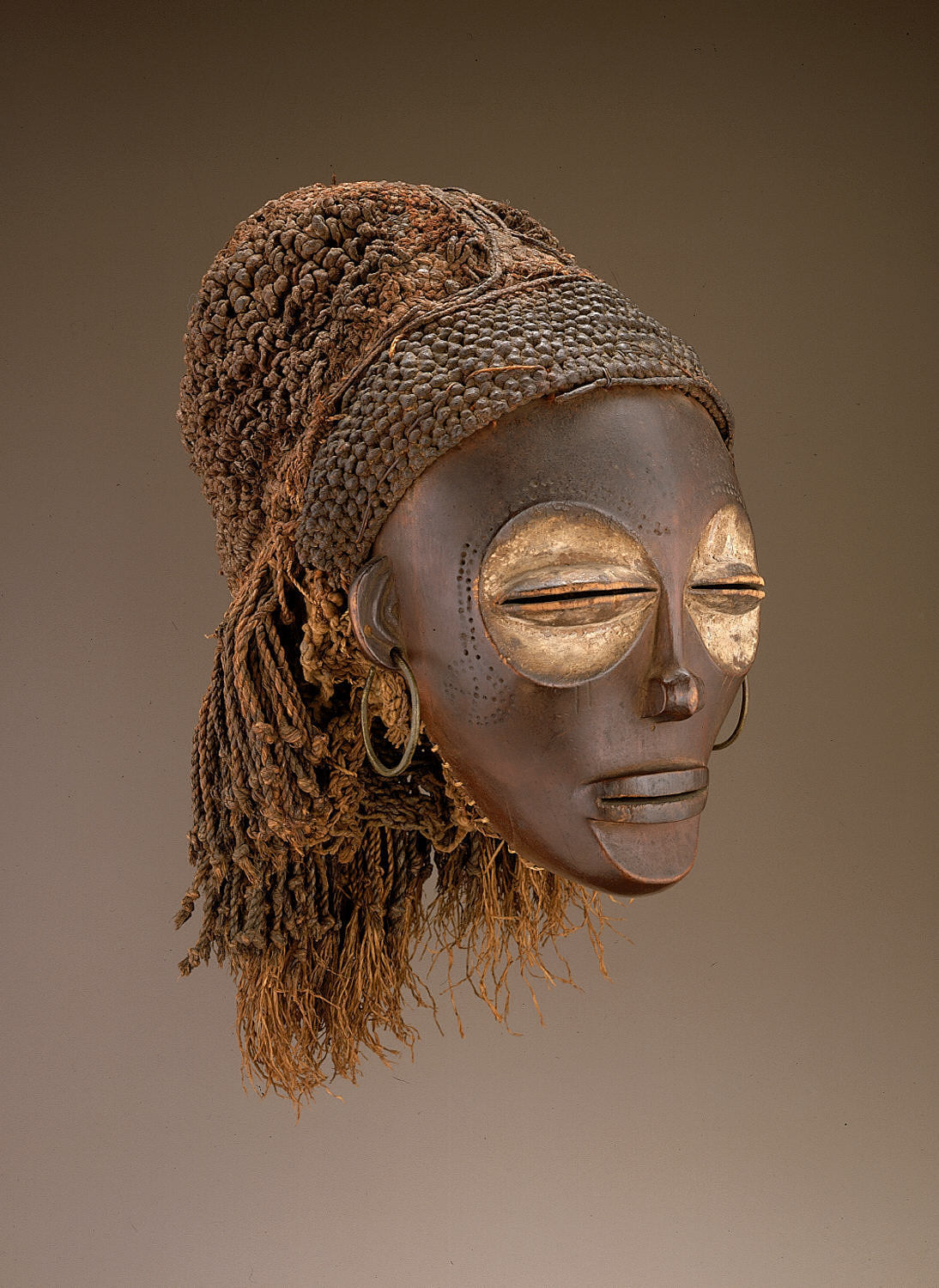African Art - Ap Art History
African Art in AP Art History
African art is a diverse and rich tradition that encompasses a wide range of styles, materials, and techniques.
It is characterized by its emphasis on the human form, which is often stylized and abstracted to convey spiritual or symbolic meaning.
African art is also known for its use of natural materials such as wood, ivory, and clay, as well as its incorporation of found objects and recycled materials.
The art of Africa is deeply rooted in the continent's history and cultural traditions, and reflects the diversity of its people and their experiences.
Some of the most famous examples of African art include the Benin bronzes, the masks of the Dan people, and the sculptures of the Nok culture.
African art has had a significant impact on the development of modern art, particularly in the early 20th century when artists such as Pablo Picasso and Henri Matisse were inspired by its bold forms and expressive power.
Today, African art continues to inspire and influence artists around the world, and is celebrated for its beauty, creativity, and cultural significance.
Conical Tower and Circular Wall of Great Zimbabwe, Shona
Dwellings for Shona royalty. Venerated houses of stone.
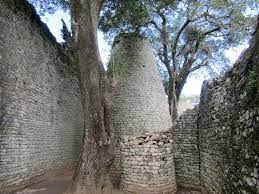
Conical Tower:
Built in the 15th century CE
Made of granite blocks without mortar
Stands at 30 feet tall
Served as a symbol of power and authority
Likely used for religious or ritual purposes
Circular Wall:
Built in the 14th century CE
Made of granite blocks without mortar
Stands at 30 feet tall and 820 feet in circumference
Served as a defensive structure for the city
Features a series of passageways and enclosures within the wall.
Great Mosque of Djenne, Mali
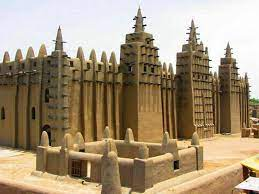
Location: Djenne, Mali
Built in: 13th century
Style: Sudano-Sahelian architecture
Materials: Adobe bricks, mud plaster
Size: 75m x 75m, tallest minaret is 16m
Importance: UNESCO World Heritage Site, largest mud-brick building in the world, center of Islamic culture in Mali.
Great Mosque of Djenne
made out of adobe, bricks, and wood.
contains four minarets, qibla and mihrab gate facing Mecca.
meant for Islamic prayer / mosque.
people annually repairs the mosque.
largest mud brick structure in the world; rebuilt three times over the years.
ostrich eggs are placed on top of the minarets (symbolic of fertility and prosperity).
Wall Plaque from Oba’s Palace, Edo
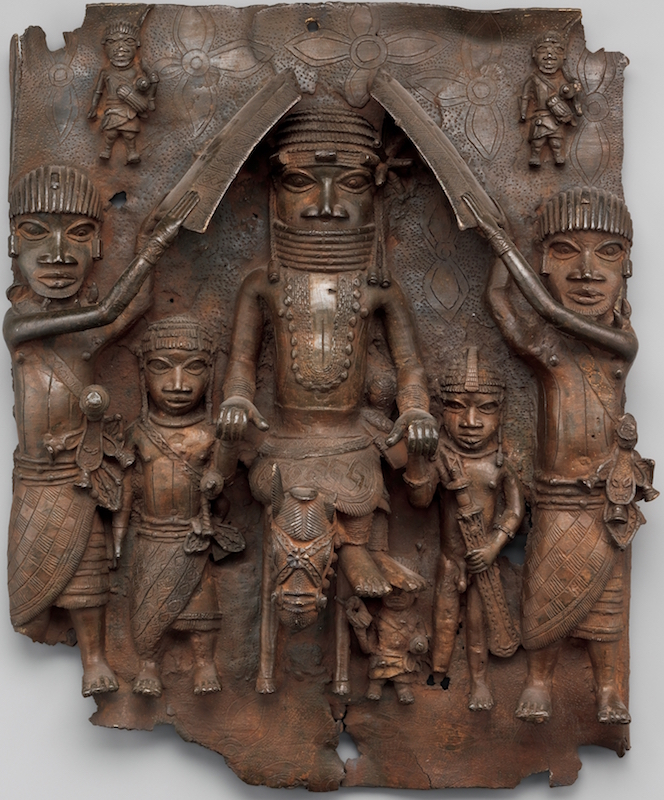
The Wall Plaque from Oba's Palace is a bronze plaque that was created in the 16th century in the Kingdom of Benin, which is now modern-day Nigeria.
The plaque is made of bronze and is approximately 22 inches tall and 18 inches wide. It features intricate designs and details that depict the daily life and culture of the Benin people.
The plaque was originally located in the palace of the Oba, or king, of Benin. It was one of many plaques that adorned the walls of the palace, which was known for its elaborate and ornate decorations.
The Wall Plaque from Oba's Palace is considered to be a masterpiece of African art. It is highly valued f
or its historical and cultural significance, as well as its artistic merit.
The plaque was acquired by the British during their colonial rule of Nigeria in the late 19th century. It is now part of the collection of the British Museum in London, where it is on display for visitors to see.
The Wall Plaque from Oba's Palace is an important artifact that provides insight into the rich history and culture of the Kingdom of Benin. It serves as a reminder of the artistic achievements of African civilizations and the importance of preserving cultural heritage.
Wall Plaque from Oba’s Palace
similar to Shiba, Lord of the Dance, by the use of the lost wax technique, hierarchical scale.
made out of cast brass, a plaque.
created by dedicated Nigerian artists to honor the Oba.
demonstrates the Oba’s power and authority.
Obas are descendants of the original Oba king (King Oranmiyan, founder of Oba dynasty).
Obas have their own personal hand-holder and shade provider.
Sika Dwa Kofi (Golden Stool), Ashanti
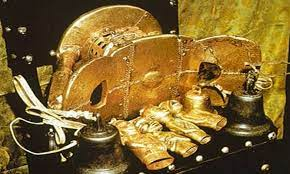
Sika Dwa Kofi (Golden Stool):
Osei Tutu is one of the first Ashanti chiefs; received the Golden Stool from the heavens.
the Golden Stool is not meant to be sat on, touched, or let it touch ground (sacred).
Name: Sika Dwa Kofi (Golden Stool)
Culture: Ashanti people of Ghana
Material: Solid gold
Function: Symbol of Ashanti unity and power
Beliefs: Legend says it descended from the sky and holds the spirit of the Ashanti people
Importance: Considered sacred and never allowed to touch the ground
History: Created in the early 18th century, hidden from British colonizers, and still serves as a symbol of Ashanti identity today. (War of the Golden Stool).
Ndop (Portrait Figure) of King Mishe, Kuba
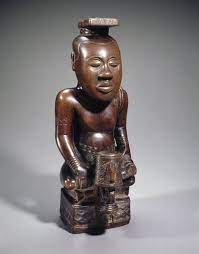
Ndop is a wooden sculpture made by the Kuba people of Central Africa.
It was created in the 18th century to represent King Mishe, who ruled the Kuba kingdom from 1750 to 1780.
Ndop is a highly stylized portrait figure that represents the king's idealized form rather than his physical likeness.
The sculpture is carved from a single piece of wood and stands at 41 inches tall.
Ndop is adorned with intricate patterns and symbols that represent the king's power and authority.
The sculpture is also decorated with cowrie shells, which were a symbol of wealth and status in Kuba culture.
Ndop was used in Kuba ceremonies and was believed to embody the king's spirit and power.
The sculpture was kept in the king's palace and was only seen by a select few individuals.
Ndop is an important example of African art and is considered a masterpiece of Kuba sculpture.
It is currently housed in the Musée du quai Branly in Paris, France.
Ndop (Portrait Figure) of King Mishe
iconography, symbols of Kuban rulers
polished wood sculpture; idealized version of King Mishe
not an exact portrait of said king; emphasis on iconography and symbolism to portray an individual king
King Mishe´s Ndop depicts him cross-legged sitting down with a severed right hand, drum, and a blade on the left hand.
the wood is polished to prevent termites from entering and to maintain it’s form.
Power Figure (Niksi n’Kondi), Kongo
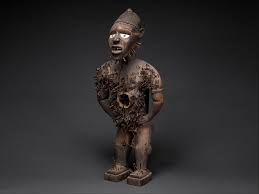
Name: Power Figure (Niksi n'Kondi)
Culture: Kongo peoples
Date: Late 19th century
Material: Wood, metal, nails, organic materials
Function: Used in religious rituals to harness spiritual power and protect against evil
Characteristics: Stylized human figure with nails and other objects inserted into the body, often with a container in the abdomen for holding magical substances
Significance: Represents the Kongo belief in the power of spiritual forces and the importance of protection against malevolent spirits.
Power Figure (Niksi n’Kondi)
a form of voodoo; priests and shamans amongst the Kongo people are responsible for dealing the requests of their clients.
Power figure is made out of wood; plunged in with nails or dagger to make a request come true.
disproportionate, simplistic; mirror almond-shaped eyes to reflect the client’s image, full-lipped.
composite creature
Portrait Mask (Mblo), Baule
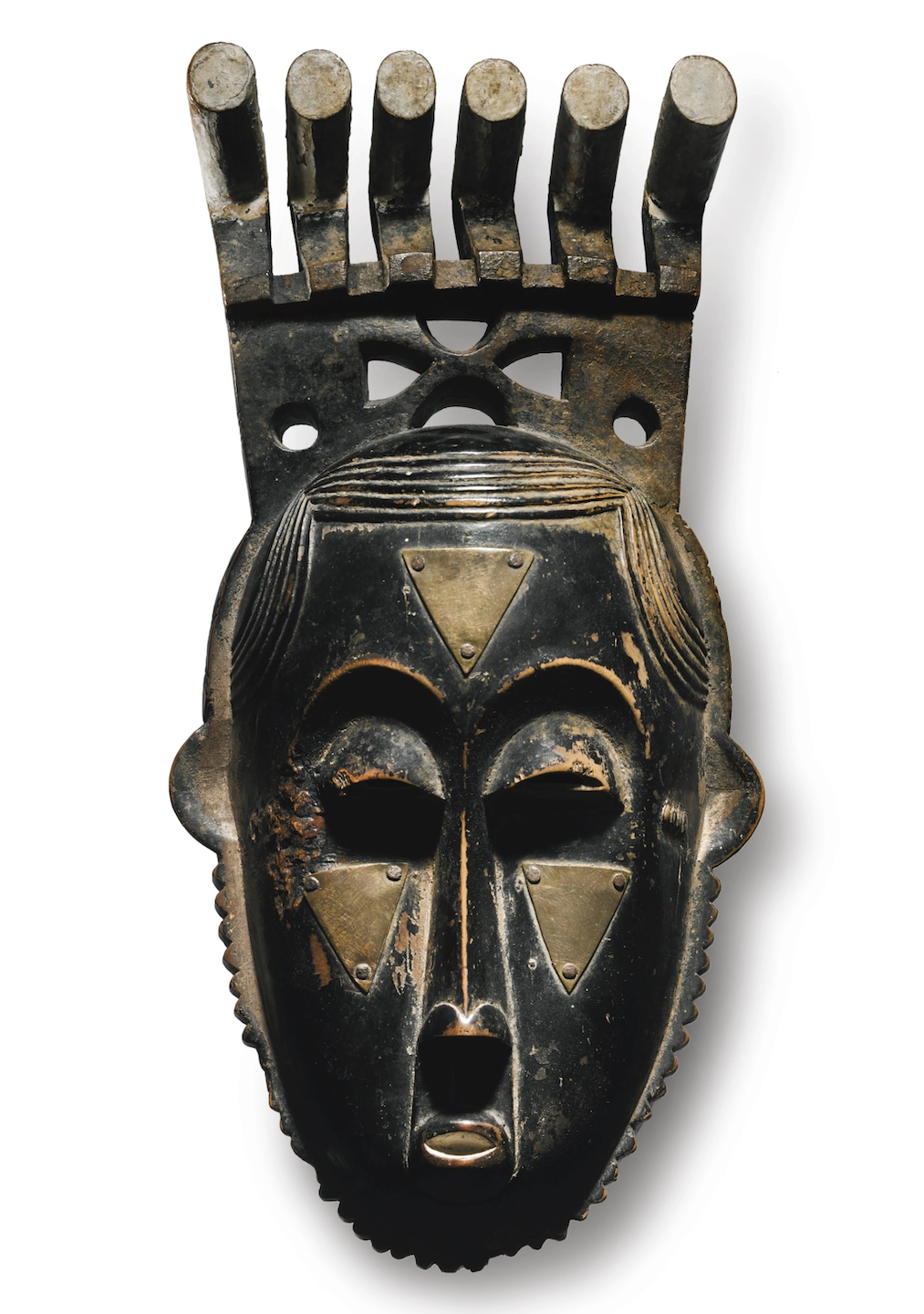
Portrait Mask (Mblo)
commissioned by groups of admirers, according to Baule traditions.
created to commemorate an ancestor, person, or important visitor of the Baule tribe.
Bundu Mask in AP Art History, Mende
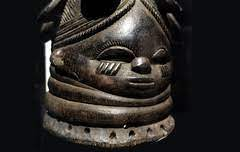
Bundu Mask
The Bundu Mask is a significant piece of art in the African art history. It is a mask that is worn by women of the Sande society in Sierra Leone during initiation ceremonies. Here are some key points about the Bundu Mask:
The mask is made of wood and is carved to represent the idealized female beauty standards of the Sande society.
The mask is painted with white pigment, which represents the purity and beauty of the Sande society's ideals.
The mask is worn by women during initiation ceremonies, which mark the transition from childhood to adulthood.
The mask is believed to have spiritual powers that protect the women during the initiation process and throughout their lives.
The mask is also used in performances and dances that celebrate the beauty and power of women in the Sande society.
The Bundu Mask is an example of the importance of art in African societies, where art is not just a form of expression but also a way of preserving cultural traditions and beliefs.
Overall, the Bundu Mask is a significant piece of art that represents the beauty and power of women in the Sande society. It is a testament to the importance of art in preserving cultural traditions and beliefs.
Female Pwo Mask, Chokwe
The Female (Pwo) Mask is a Chokwe mask from Angola, Africa.
It is a representation of a female ancestor or a spirit of fertility and is used in initiation ceremonies and other important events.
The mask is made of wood, fiber, and pigment, and is decorated with geometric patterns and scarification marks.
The mask has a high forehead, slit eyes, and a small mouth, which are typical of Chokwe art.
The Pwo mask is worn by male dancers who perform in pairs during ceremonies.
The dance is accompanied by music and singing, and the dancers move in a slow, graceful manner.
The mask is believed to have the power to bring fertility and prosperity to the community.
The Pwo mask is an important symbol of Chokwe culture and is still used in traditional ceremonies today.
Ikenga (Shrine Figures, Igbo)
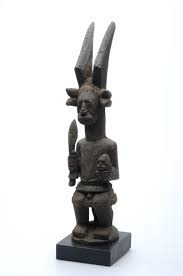
Ikenga (Shrine Figures)
Ikenga is a term used to describe a type of portrait figure that is common in the Igbo culture of Nigeria.
These figures are usually made of wood and are used to represent an individual's personal god or spirit.
The word "Ikenga" means "strength" or "power" in the Igbo language, and these figures are believed to embody these qualities.
Ikenga figures are typically depicted as muscular and powerful, with a prominent jaw and a fierce expression.
They are often shown holding a sword or other weapon, symbolizing the individual's ability to defend themselves and their community.
Ikenga figures were traditionally created by skilled carvers and were considered to be a status symbol among the Igbo people.
They were often displayed in the owner's home or shrine and were used in religious ceremonies and rituals.
Today, Ikenga figures are still created and used in some parts of Nigeria, although their significance and use has evolved over time.
In AP Art History, Ikenga figures are studied as an example of the ways in which art can reflect and embody cultural beliefs and values.
Lukasa (Memory Board), Luba
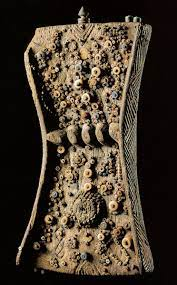
Lukasa Memory Board in AP Art History
Lukasa Memory Board is a type of memory device used by the Luba people of Central Africa.
It is a wooden board with beads, shells, and other objects attached to it.
The board is used by the Luba people to record their history, myths, and genealogy.
The Lukasa Memory Board is considered a sacred object and is used in important ceremonies and rituals.
The board is held by a trained keeper who recites the history and myths associated with the objects on the board.
The Lukasa Memory Board is an important example of how African cultures have developed sophisticated ways of recording and transmitting knowledge and history.
The Lukasa Memory Board is an important artifact in the study of African art and culture.
It is also an important example of how art can be used as a tool for memory and storytelling.
The Lukasa Memory Board is an important example of how art can be used to preserve and transmit cultural knowledge across generations.
Aka Elephant Mask, Bamileke
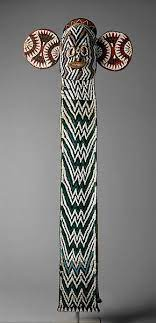
The Aka Elephant Mask is a ceremonial mask from the Bamileke people of Cameroon, Africa. It is a significant piece of art in the AP Art History curriculum. Here are some key points to remember:
The mask is made of wood and covered in a layer of brass. It is designed to resemble an elephant's head, with large tusks and a trunk.
The mask is worn during important ceremonies, such as funerals, to honor the deceased. It is also used during agricultural festivals to bring good luck and prosperity.
The Bamileke people believe that the elephant is a symbol of power and strength, and the mask is meant to embody these qualities.
The intricate designs on the mask, such as the raised patterns and the use of negative space, are typical of Bamileke art. The brass covering also adds a reflective quality to the mask, making it even more striking.
The Aka Elephant Mask is an example of how art can be used to convey cultural beliefs and values. It is a powerful symbol of the Bamileke people's connection to the natural world and their reverence for the elephant.
Overall, the Aka Elephant Mask is an important piece of African art that showcases the creativity and cultural significance of the Bamileke people.
Lukasa (Memory Board), Mbudye
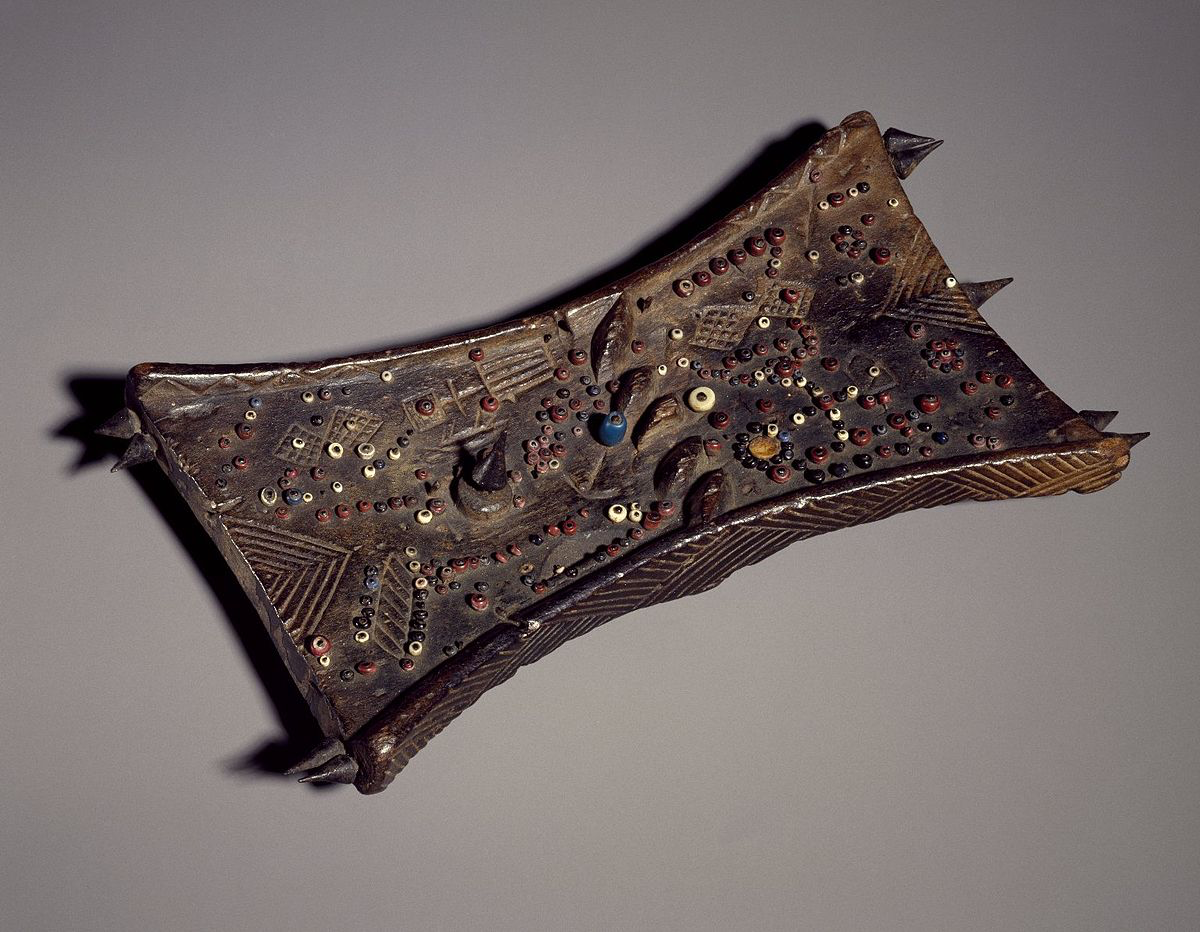
Lukasa Memory Board
Lukasa memory board is a type of memory device used by the Luba people of Central Africa. It is a handheld wooden board that is covered with beads, shells, and other materials. The board is used by the Luba people to record their history, traditions, and other important information.
History
The Lukasa memory board was first used by the Luba people in the 17th century. It was used as a tool for recording their history and traditions. The board was also used by the Luba people to pass down their knowledge and traditions from one generation to the next.
Design
The Lukasa memory board is made of wood and is covered with beads, shells, and other materials. The board is divided into different sections, each of which represents a different aspect of Luba culture. The beads and shells on the board are arranged in specific patterns that represent different events and ideas.
Function
The Lukasa memory board is used by the Luba people to record their history, traditions, and other important information. The board is also used as a teaching tool to pass down knowledge and traditions from one generation to the next. The Lukasa memory board is still used by the Luba people today.
Significance
The Lukasa memory board is significant because it represents the rich cultural heritage of the Luba people. It is also significant because it is a unique and innovative way of recording history and passing down knowledge. The Lukasa memory board is considered a work of art and is highly valued by the Luba people.
AP Art History
The Lukasa memory board is an important artifact in AP Art History. It is an example of how different cultures use art to record their history and traditions. The Lukasa memory board is also an example of how art can be used as a teaching tool to pass down knowledge and traditions from one generation to the next.
Reliquary Figure (Nlo Bieri), Fang
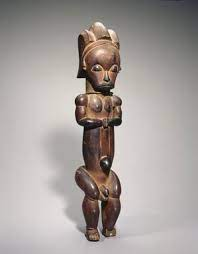
Culture: Fang people of Gabon
Materials: Wood, metal, organic materials
Function: Served as a container for relics of ancestors
Form: Abstract, elongated body with geometric shapes and patterns
Symbolism: Represents the duality of life and death, the spiritual and physical worlds
Importance: Considered a sacred object and used in religious ceremonies
Influences: May have influenced modernist artists such as Pablo Picasso and Henri Matisse.
Veranda Post, Yoruba
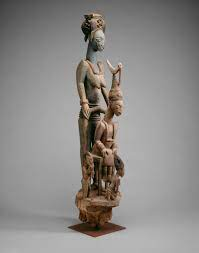
Artist: Olowe of Ise
Date: Early 20th century
Culture: Yoruba
Medium: Wood and pigment
Function: Decorative post for a veranda
Style: Naturalistic and abstract
Symbolism: Depicts Yoruba deities and their attributes
Technique: Carved in the round with intricate details
Importance: Represents the pinnacle of Yoruba woodcarving tradition
Location: Originally from the palace of the Ooni of Ife, now in the collection of the National Museum of African Art in Washington, D.C.
 Knowt
Knowt

